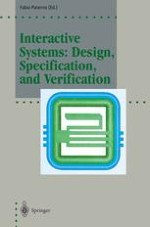
1995 | OriginalPaper | Buchkapitel
History, Results, and Bibliography of the User Interface Design Environment (UIDE), an Early Model-based System for User Interface Design and Implementation
verfasst von : James D. Foley, Piyawadee “Noi” Sukaviriya
Erschienen in: Interactive Systems: Design, Specification, and Verification
Verlag: Springer Berlin Heidelberg
Enthalten in: Professional Book Archive
Aktivieren Sie unsere intelligente Suche, um passende Fachinhalte oder Patente zu finden.
Wählen Sie Textabschnitte aus um mit Künstlicher Intelligenz passenden Patente zu finden. powered by
Markieren Sie Textabschnitte, um KI-gestützt weitere passende Inhalte zu finden. powered by
UIDE, the User Interface Design Environment, was conceived in 1987 as a next-generation user interface design and implementation tool to embed application semantics into the earlier generation of User Interface Management Systems (UIMSs), which focused more on the look and feel of an interface. UIDE models an application’s data objects, actions, and attributes, and the pre- and post- conditions associated with the actions. The model is then used for a variety of design-time and run-time services, such as to: automatically create windows, menus, and control panels; critique the design for consistency and completeness; control execution of the application; enable and disable menu items and other controls and make windows visible and invisible; generate context-sensitive animated help, in which a mouse moves on the screen to show the user how to accomplish a task; generate text help explaining why commands are disabled and what must be done to enable them; and support a set of transformations on the model which change certain user interface characteristics in a correctness-preserving way.The model-based approach represented by UIDE is considered promising for four reasons. First, the model is specified in a non-procedural fashion at a higher level of abstraction than the code which the model replaces, thus replacing verbose procedural code with terser declarative knowledge. Second, many of the services provided automatically as a consequence of having the UIDE model, such as help, would typically have to be added after the application has been constructed. Changes to the application would have to be reflected back into those services. Third, when the model changes, all of the above uses of the model can be changed automatically. Finally, some of the design-time services provided by the model would not otherwise be available at all.